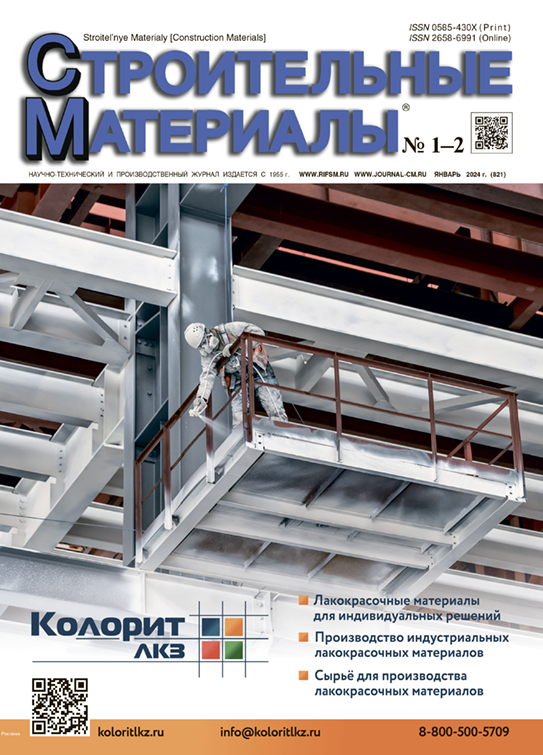The Effect of Additives Regulating the Setting Time on the Resistance of Chloromagnesial Composites to Cracking During Prolonged Water Saturation
- 作者: Averina G.F.1, Koshelev V.A.1, Kramar L.Y.1
-
隶属关系:
- South Ural State University (National Research University)
- 期: 编号 1-2 (2024)
- 页面: 110-114
- 栏目: Modern concretes
- URL: https://journals.eco-vector.com/0585-430X/article/view/635980
- DOI: https://doi.org/10.31659/0585-430X-2024-821-1-2-110-114
- ID: 635980
如何引用文章
详细
The resistance of chloromagnesial composites to prolonged water saturation is determined by the softening coefficient and the tendency to cracking. Technological methods for preventing the cracking of a magnesia binder stone in contact with water have a number of disadvantages, in particular, related to their difficult reproducibility in production conditions. This study is devoted to the search for additives that make it possible to regulate the processes of structure formation of chloro-magnesial composites in order to form predominantly stable phases evenly distributed in volume during prolonged saturation with water. In the course of the work, standard methods were used to study the properties of dough and astringent stone, as well as microcalorimetry. As a result, it was found that the addition of sodium tripolyphosphate significantly slows down the setting time of the chloromagnesial composition, but eliminates the tendency of the artificial stone obtained from it to crack during prolonged water saturation.
全文:
作者简介
G. Averina
South Ural State University (National Research University)
编辑信件的主要联系方式.
Email: avergf@gmail.com
Candidate of Sciences (Engineering)
俄罗斯联邦, ChelyabinskV. Koshelev
South Ural State University (National Research University)
Email: vasilikosh@gmail.com
Graduate student
俄罗斯联邦, ChelyabinskL. Kramar
South Ural State University (National Research University)
Email: kramarli@susu.ru
Doctor of Sciences (Engineering)
俄罗斯联邦, Chelyabinsk参考
- Vinnichenko V.I., Ryazanov A.N. Resource- and energy-saving binders from dolomite waste. Energy- and resource-saving environmentally friendly chemical-technological processes for environmental protection. Belgorod. November 24–25, 2015, pp. 22–32. (In Russian).
- Nosov A.V. High-strength dolomite binder. Vestnik of the South Ural State University. Series: Construction and architecture. 2013. Vol. 13. No. 1, pp. 30–37. (In Rissian).
- Uryasheva N.N., Kovaleva O.I., Kovalev N.V. Research of the magnesia cement stability to the impact of corrosive biological environments. IOP Conference Series: Materials Science and Engineering. 2018. Vol. 451. No. 1. 012035. doi: 10.1088/1757-899X/451/1/012035
- Lauermannová A.M., Lojka M., Jankovský O., Faltysová I., Pavlíková M., Pivák A., Záleská M., Pavlík Z. High-performance magnesium oxychloride composites with silica sand and diatomite. Journal of Materials Research and Technology. 2021. Vol. 11, pp. 957–969. https://doi.org/10.1016/j.jmrt.2021.01.028
- Khalil A., Wang X., Celik K. 3D printable magnesium oxide concrete: towards sustainable modern architecture. Additive Manufacturing. 2020. Vol. 33. 101145. https://doi.org/10.1016/j.addma.2020.101145
- Nosov A.V., Chernykh T.N., Kramar L.Ya. Additives-intensifiers for dolomite firing. Science SUSU. Sections of technical sciences: materials of the 66th scientific conference. Chelyabinsk. 2014, pp. 998–1002. (In Russian).
- Khuziakhmetov R.Kh. Technology of magnesium binders from dolomite powder and assessment of the quality of firing products. Vestnik of the Kazan Technological University. 2013. Vol. 16. No. 7, pp. 101–107. (In Russian).
- Kramar L.Ya., Chernyh T.N., Trofimov B.Ya. Peculiarities of hardening of magnesium binder. Cement i ego primenenie. 2006. No. 5, pp. 58–61. (In Russian).
- Kramar L.Ya., Nuzhdin S.V., Trofimov B.Ya. Compositions based on magnesium binder, not prone to cracking during operation. Vestnik of the South Ural State University. Series: Construction and architecture. 2007. No. 14 (86), pp. 15–17. (In Russian).
- Elenova A.A., Krivoborodov Yu.R. Influence of hydrodynamically activated crystalline hydrate additive on hydration and hardening of cement stone. Uspekhi v khimii i khimicheskoi tekhnologii. 2016. Vol. 30. No. 7 (176), pp. 36–38. (In Russian).
- Krivoborodov Yu.R., Boiko A.A. Influence of mineral additives on the hydration of aluminous cement. Tekhnika i tekhnologiya silikatov. 2011. Vol. 18. No. 4, pp. 12–15. (In Russian).
- Guvalov A.A., Kabus’ A.V., Usherov-Marshak A.V. Influence of organomineral additives on early hydration of cement. Stroitel’nye Materialy [Construction Materials]. 2013. No. 9, pp. 94–95. (In Russian).
- Ba H., Guan H. Influence of MgO/MgCl2 molar ratio on phase stability of magnesium oxychloride cement. Journal of Wuhan University of Technology-Mater. Sci. Ed. 2009. Vol. 24. No. 3, pp. 476–481. https://doi.org/10.1007/s11595-009-3476-3
- Murashkevich A.N. Khimicheskaya tekhnologiya materialov i izdeliy elektronnoy tekhniki [Chemical technology of materials and electronic products]. Minsk: BGTU. 2013. 297.
- Averina G.F., Koshelev V.A., Kramar L.Y. Combined roasting of raw materials modified by additives-intensifiers in form of low humidity sludge. IOP Conference Series: Materials Science and Engineering. 2019. Vol. 687. Iss. 2. 022038. doi: 10.1088/1757-899X/687/2/022038
- Averina G.F., Katasonova A.V., Zimich V.V., Chernykh T.N. Increasing the water resistance of magnesium stone for hardening backfill mixtures from technogenic dolomites. Vestnik of the South Ural State University. Series: Construction and architecture. 2016. Vol. 16. No. 2, pp. 28–32. (In Russian).
补充文件









